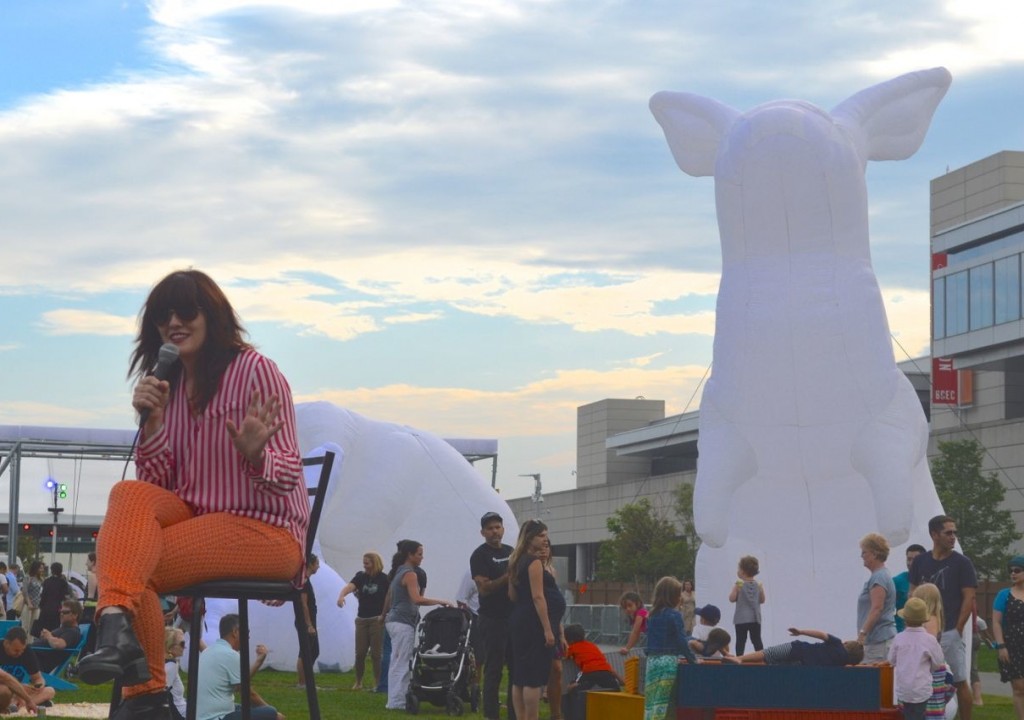
The Lawn on D – the Boston Convention and Exhibition Center’s experimental park in the South Boston Seaport – currently looks like something out of Alice’s Adventures in Wonderland. That is to say, there are five two-story inflatable rabbits occupying the green space along with other distorted art installations intended to prompt spectators to reconsider notions of size, spectacle and play.
The rabbits are part of Tasmanian artist Amanda Parer’s exhibit called Intrude, open Thursday through Sunday, which acted as the backdrop for a panel discussion with Parer and other artists whose works are featured on The Lawn on D, aptly called “Play in Public Art.”
In less than a year The Lawn on D has established itself as one of Boston’s foremost transformative public spaces, featuring not only the likes of Intrude but also the LED lit circular swings known as Swing Time and, recently, an inflatable light-refracting playhouse called Pentalum.
These three works, along with plenty others, are representative of Boston’s public art emergence over the last couple of years as well as a break from the traditional bronze statues and regal portraits currently scattered throughout the city and adorning various walls.
“The thing that these pieces bring forward is a spirit of play and a sense of humor,” said Chris Wangro, art producer at The Lawn on D. “They are a spectacle.”
Creating playable spaces and generally playable cities is more than a new civic trend. Playability is crucial to the quality of life among city residents. Whereas a smart city will provide technological advantages and next-gen items, it doesn’t necessarily provide anything that spurs enjoyment and overall happiness.
The primary function of playable features is not to serve a specific function but rather to elicit, foster and promote positive emotions. And residents are certainly privy to this notion easily buying into initiatives like the City Hall Plaza redesign, taking up ping pong and pool at Faneuil Hall Marketplace and eagerly awaiting a free indoor skatepark.
“I use rabbits because they’re humorous,” said Parer. “When people approach it they’re reminded of childhood stories, or the Easter Bunny, or Alice in Wonderland. They enter the themes in a playful way.”
For the work of Parer and Kelly Goff, whose miniature urethane foam shipping containers were a smashing success among children at The Lawn on D, artwork can be playable while also conveying significant messages that aren’t hampered by tedious doctrines.
Goff grew up next to an oil rig in the Caribbean and the grittiness exuded from that heavily influences every piece he creates. For his containers, he wanted to showcase how humanity is bigger and more imposing than oil and its industry, not the other way around.
For Parer, her rabbits are shown to be in command of the environment instead of being victim to it.
“I enlarge them in my paintings and here, as you can see, because I want them dominating the environment,” said Parer. “I use them as a metaphor. In a lot of cases we’re mismanaging the environment.”
Playable art with a message prompts interaction with both the art and between the viewers themselves. This allows people to discern who they are, the identity of their city, what kind of cultural facets they want reflecting those ideals.
And, perhaps most importantly, these kind of works help propel these conversations into perpetuity.
“In wanting to make this city better, I fell into public art as one of interesting ways that’s not an event, not that labor intensive, and uses the vision and the thought of an artist to help draw out a community dialogue,” said Kate Gilbert, curator of The Lawn on D’s D Street ArtLAB.

